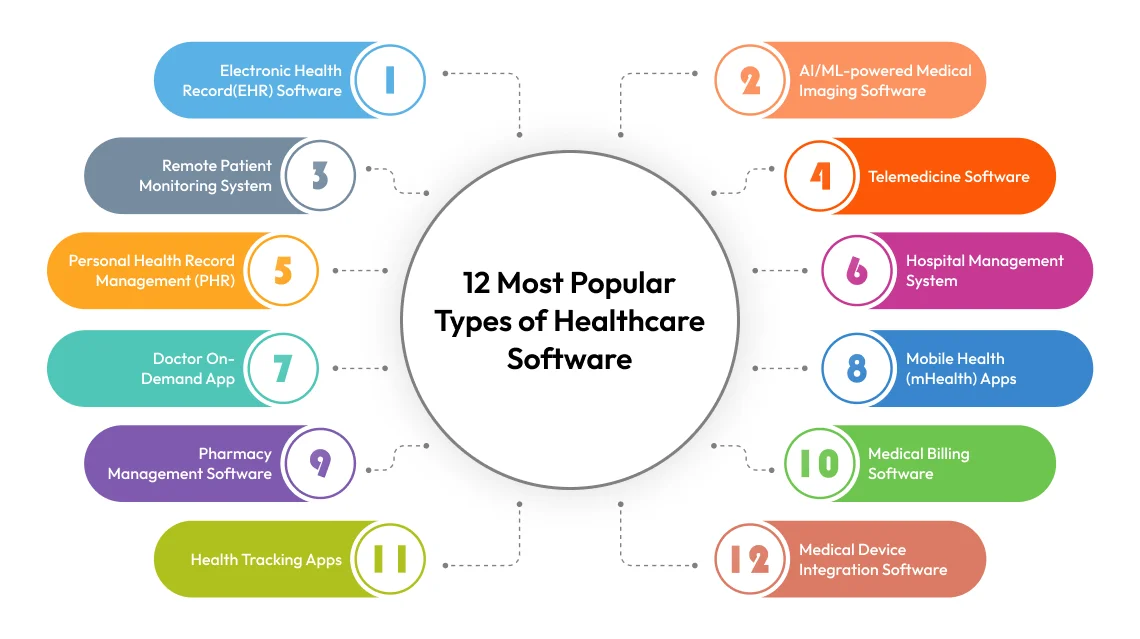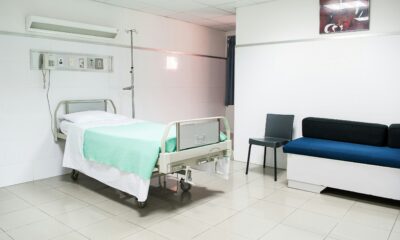Technology
12 Most Popular Types of Software Used in Healthcare Industry

From electronic health records to doctor-on-demand apps, healthcare businesses utilize various software for healthcare to meet diverse operational and patient care requirements. Our development team, which stays in close touch with the latest healthcare trends, has curated a list of the most searched types of healthcare software in recent years. Read this blog to explore these different types of healthcare software, their key features, and the unique advantages they offer to various healthcare organizations.
We live in a world where video healthcare consultations are the new normal. Many of us have experienced the power of mobile devices in connecting us to doctors from around the globe, enabling top-tier healthcare consultations via video conferencing without the need to travel. This not only saves us millions of dollars in travel and accommodation expenses but also makes healthcare more accessible and convenient.
This is just one of many high-tech healthcare software examples that bridge the gap between patients and essential healthcare services. However, the benefits of high-tech healthcare software extend beyond just the patient experience.
There are various types of software tailored to meet the needs of hospitals, primary care practices, pharmacies, health insurance companies, laboratories, and more. Each type plays a crucial role in enhancing efficiency and care within the healthcare system.
Before we dive into the various types of software used in the healthcare industry, let’s first take a look at an overview of the healthcare software market.
Healthcare Software Market: An Overview
The healthcare software market encompasses a broad range of technologies designed to enhance patient care, streamline operations, and ensure regulatory compliance. Let us understand the current landscape of healthcare software systems.
- The global digital health market, valued at over $330 billion in 2022, is projected to surpass $650 billion by 2025, reflecting increasing adoption of digital health technologies and rising demand for innovative solutions in the healthcare sector.
- By 2027, the global market for Electronic Health Records (EHRs) is projected to exceed $47 billion.
- The revenue for online doctor consultations is anticipated to grow by 36.14% from 2024 to 2028, reaching approximately $35.83 billion by the end of 2028.
- Forecasts suggest substantial growth in the global smart hospital market, with projections indicating it will expand from $35.9 billion in 2021 to nearly $58 billion by 2026.
- Out of the above $35.9 billion, $10.6 billion is attributed to remote medicine. Looking ahead, projections suggest that the value of remote medicine management within smart hospitals will increase substantially, reaching nearly $24 billion by 2026.
Now that we understand the growing adoption of technology and the need for digital solutions in the healthcare industry, let’s explore the different types of healthcare software in detail.
12 Most Popular Types of Healthcare Software
With numerous software solutions available, it can be challenging to determine which types best suit the diverse needs of healthcare organizations. From electronic health records to telemedicine platforms, each software type offers unique features and benefits designed to address specific challenges and optimize healthcare delivery.


Here are some key healthcare software systems to consider for your requirements:
1. Electronic Health Record(EHR) Software
EHR systems make patient information centrally available to authorized users. These electronic patient record software store real-time, up-to-date, patient-centered clinical, administrative, and other information, including medical history, allergies, past medical conditions, vital signs, lab results, diagnoses, progress notes, insurance information, financial details, healthcare plans, consent forms, and more.
EHR systems are comprehensive digital records which also include the patient’s information from multiple healthcare providers and facilities.
If a healthcare organization seeks an internal system for managing patient information and medical records, it may consider Electronic Medical Record (EMR) systems instead of EHR. These systems are focused on documenting patient care within a single practice or facility and are intended for internal use only. Unlike EHR systems, EMRs offer limited to no interoperability outside the organization.
Additionally, there is Electronic Patient Record (EPR) software, which is a subset of EHR systems, similar to EMR systems. EPR software includes capabilities for internal integration within the organization. In terms of integration, EPR systems offer internal inter-departmental integration and some degree of external data-sharing capabilities.
The key features of Electronic Health Record (EHR) Software are:
- E-prescribing
- Patient portal
- Medication management
- Appointment scheduling
- Immunization management
- Analytics and reporting
- Patient demographics management
These software systems offer a multitude of benefits to healthcare organizations. Here are some key benefits of EHR software:
- With complete information available, patient care is significantly enhanced.
- Streamlines processes, improves workflow, and reduces paperwork, leading to greater efficiency.
- Secure data storage ensures the protection of sensitive patient information.
- Simplified reporting and automatic tracking enable compliance with regulatory standards.
- Seamless sharing of information across different healthcare systems fosters better collaboration.
2. AI/ML-powered Medical Imaging Software
Medical imaging software is used to analyze and interpret medical images such as X-rays, MRIs, CT scans, PET scans, ultrasounds, echocardiograms, and more. Unlike in the past, when medical images were analyzed manually, making the process time-consuming and prone to human errors, these software programs use advanced algorithms to analyze and interpret these images.
The software is instrumental in detecting abnormalities, providing accurate diagnoses, facilitating early detection, reconstructing images, enhancing image quality, enabling 3D visualization, and more.
The key features of AI/ML-powered imaging software are:
- Predictive analysis
- Automated image analysis
- 3D Reconstruction and visualization
- Customizable AI models and algorithms
- Quantitative image analysis
- Workflow optimization and efficiency
From reduced errors to faster analysis, here are the key benefits of medical imaging software powered by the latest imaging technologies:
- Increases diagnostic accuracy by detecting abnormalities that radiologists might miss.
- Facilitates analysis of large volumes of images, empowering organizations to scale their operations easily.
- Allows timely interventions and better treatment of life-threatening diseases like cancer through early detection and identification.
- Helps analyze large datasets to identify trends and patterns for better prediction.
- Improves overall workflow efficiency and reduces operational costs.
- Enables physicians to create customized treatment plans based on the analysis of a patient’s medical history and imaging data.


3. Remote Patient Monitoring System
With the shift toward offering patient-centered care, the size of the global remote monitoring market is increasing substantially, hinting at the adoption of these systems in the near future. According to Markets and Markets, this market in terms of revenue is expected to grow with a CAGR of 23.6% during the forecast period of 2023 to 2028, from $71.9 billion to $207.5 billion respectively.
RMS is a boon of many sorts, especially for patients in rural or underserved areas. These systems eliminate the need for long-distance travel for these patients to access high-quality healthcare. These systems are designed to monitor, collect, transmit, and analyze patient health data remotely.
RPM technology leverages a wide range of devices including wearable devices, vital signs monitoring devices, cardiac monitoring devices, chronic disease management devices, and more.
Some key features of Remote Patient Monitoring system are:
- Real-time health data access and collection
- Automated alerts and notifications
- Patient data storage, transmission, and management
- Customizable monitoring parameters
- Seamless integration with EHR systems and telehealth platforms
- Customizable dashboards for healthcare providers
Here’s how your healthcare organization can benefit from implementing an RPM system:
- Ensures seamless data exchange across healthcare systems.
- Continuous monitoring of a patient’s vital signs and health metrics improves health outcomes.
- Automates the collection and transmission of health data, streamlining administrative tasks.
- Provides accurate and up-to-date information, facilitating personalized care plans and better decision-making.
- Increases patient base and geographic reach by offering services in remote and underserved areas.
4. Telemedicine Software
Telemedicine software is a digital platform that enables healthcare professionals and patients to conduct medical consultations and manage healthcare remotely, using technology to facilitate communication and provide medical services.
Telemedicine software has been one of the most appreciated digital solutions during healthcare crises, such as the COVID-19 pandemic. These platforms allowed patients to overcome the barriers of quarantine and lockdowns to access primary care, mental health services, and more.
This software typically includes a range of features designed to support various aspects of telemedicine, from virtual consultations to health management.
A robust telemedicine solution includes the following key features:
- Real-time video consultations
- Appointment scheduling
- Electronic Health Records (EHR) integration
- Prescription management
- Remote monitoring integration
- Billing and payment processing
- User management
- Analytics and reporting
Here’s how a telemedicine solution can benefit your healthcare business:
- Expands patient access to healthcare services, including those in remote areas
- Streamlines administrative processes, reducing the workload for staff and increasing efficiency
- Opens up new revenue streams through remote consultations, boosting overall profitability
- Attracts tech-savvy patients by offering modern and convenient healthcare options
- Encourages regular follow-ups and continuous care
- Differentiates your practice or healthcare organization in a competitive market
- Improves multidisciplinary care by facilitating easier coordination between healthcare providers
- Offers scalability to accommodate a growing patient base as your business expands
5. Personal Health Record Management (PHR)
A PHR is a comprehensive, patient-managed document that includes an individual’s health information. With this software, patients can store, manage, and access their health data in a digital format. This information can include medical history, immunization records, lab results, treatments, procedures, emergency contacts, and more.
These systems can be integrated with health systems and can also be connected to EHR systems, which are maintained by healthcare providers.
Here are the key features of a PHR system:
- Patient Registration and Profile Management
- Medical Records Access
- Prescription management
- Medication Management
- Health Monitoring
- Personalized Health Insights
- Billing and Insurance Management
- Health Goals and Reminders
- Educational Resources
Here are the key business benefits of adopting a PHR system:
- Provides patients with access to their health records
- Facilitates seamless information sharing among healthcare providers
- Automates the management of patient records, reducing administrative tasks
- Offers a convenient and transparent way for patients to manage their health information
6. Hospital Management System
It is an integrated software solution designed to streamline and manage various administrative, clinical, financial, and operational functions within a hospital or healthcare facility. It involves managing every aspect of a healthcare organization. These aspects combine to form the core features of this system.
Let us understand the key features of a comprehensive HMS to know what this system is all about:
- Patient Management: Patient registration, medical history, appointment management, etc.
- Financial Management: Billing, invoicing, insurance claim processing, revenue cycle management, etc.
- Inventory Management: Tracking and managing medical supplies and pharmaceuticals.
- Human Resource Management: Employee records, payroll, shift scheduling and management, etc.
- Laboratory, Radiology, and Pharmacy Management: Coordination of lab tests, radiology imaging, medication dispensing, and more.
- Operation Theater Management: Surgery scheduling, equipment tracking, anesthesia management, etc.
- Reporting and Analytics: Customizable reports and dashboards, performance metrics, financial reports, etc.
Here is how an HMS can impact different departments within a hospital:
- Finance Department: Benefits from improved revenue cycle management, accurate financial reporting, efficient cost management, and more.
- Administration Department: Leverages automated processes, reduces paperwork, and optimizes utilization of staff and equipment.
- Human Resources: Enhances employee management, effective shift scheduling, performance management, and more.
- Laboratory and Pharmacy Departments: Improves drug interaction checks, automates test ordering and result management, and increases the efficiency of supplies and medication management.
7. Doctor On-Demand App
A Doctor On-Demand app serves as a bridge connecting patients with healthcare professionals, providing access to medical consultations, advice, and treatment from the comfort of their own homes.
With these apps, healthcare providers or startups can offer a wide range of services, such as real-time video consultations, e-prescriptions, and more to their users.
To further enhance user engagement, these apps also incorporate features like medication management, in-app messaging, chatbots, reminder notifications, and more.
A Doctor On-Demand app offers the following features to your users and your healthcare professionals:
- Patient registration and profiles
- Doctor profiles and availability
- Appointment booking
- Video consultation
- Secure in-app messaging
- Payment integration
- E-prescriptions
- Notifications and alerts
- Ratings and reviews
- Multilingual support
- Admin panel
While significantly enhancing patient care and driving business growth, here are some additional benefits of offering a Doctor On-Demand app to your users:
- Provides patients with the flexibility to consult doctors from the comfort of their homes
- Expands healthcare services beyond geographical limitations
- Streamlines appointment scheduling, patient management, and billing processes, reducing administrative burdens
- Facilitates regular follow-ups and easy access to care, encouraging patient retention
- Engages patients and promotes services through in-app notifications and health tips


8. Mobile Health (mHealth) Apps
Given the emphasis on “mobile” in its name, these apps are designed for smartphones and tablets to offer added convenience to users while leveraging mobile technology to provide tech-savvy health-related services. The core functions of these mobile apps for healthcare can vary from simple health tracking to complex disease management tools. They have become a top choice for startups planning to enter the healthcare segment of the app stores.
As far as future business potential is concerned, the global mHealth apps market size was $33.17 billion in 2023 and is expected to grow at a rate of 11.7%, reaching $88.70 billion by 2028.
The mHealth apps features are:
- Appointment scheduling
- Medication management
- Medication reminders
- Health tracking and analytics
- E-prescriptions
- Personalized health insights
- Fitness and wellness tracking
- Patient feedback
The mHealth apps offer significant business advantages for healthcare organizations. Here are some key benefits:
- Provides convenient access to healthcare services through users’ mobile devices.
- Creates additional revenue streams through in-app purchases or partnerships with other healthcare providers.
- Reduces overhead costs associated with in-person visits and traditional office management.
- Reminds patients to take medications, attend appointments, and follow treatment plans.
9. Pharmacy Management Software
Pharmacy management software is a specialized digital solution designed to streamline and optimize various pharmacy operations and inventory control, from processing prescriptions to managing inventory.
From preventing shortages and overstocking to managing refills and drug interactions, this software plays a critical role in all aspects of pharmacy management.
The pharmacy management software offers the following key features:
- Prescription Processing
- Inventory Management
- Billing and Claims Processing
- Patient Records Management
- Reporting and Analytics
Here are the benefits of including pharmacy management software in your digital healthcare software ecosystem:
- Automates tasks like inventory management, prescription processing, and billing.
- Ensures accurate dispensing of medications with proper dosages and instructions.
- Reduces wastage and overstocking with efficient inventory management, leading to cost savings.
- Easily generates reports and maintains records required for regulatory compliance.
- Maintains comprehensive patient records, allowing for better monitoring of medication histories and interactions.
10. Medical Billing Software
Medical Billing Software is a specialized system designed to streamline every aspect of billing and revenue cycle management processes, from patient registration to claims submission and payment collection. These software solutions automate billing processes to ensure accuracy and efficiency in the financial operations of any healthcare organization.
Here are some essential features that Medical Billing Software have:
- Patient Registration and Management
- Billing and invoicing
- Payment processing
- Insurance verification
- Insurance claims management
- Denied claims management
- Accounts receivable management
Here are the advantages you have of having a Medical Billing Software:
- Automates the billing process, reducing manual errors and speeding up claims submission
- Faster claims processing and reduced denials lead to quicker reimbursements
- Identifies and corrects errors before claims are submitted
- Keeps the organization compliant with healthcare regulations and standards
- Provides comprehensive financial reports that help in tracking revenue, identifying trends, and making informed business decisions
11. Health Tracking Apps
Essentially, health-tracking apps are designed to enable individuals to monitor and manage various aspects of their health and wellness.
From daily step counters to apps for monitoring calorie intake, analyzing sleep patterns, tracking menstrual cycles, and providing medication reminders, these are some of the simplest examples of health-tracking apps that users use for various aspects of life.
These apps represent considerable healthcare app ideas that startups can consider if they want to capitalize on the numerous business opportunities available in the healthcare industry.
Here are some essential features of health-tracking apps that can significantly enhance healthcare management:
- Health metrics tracking
- Goal setting and progress tracking
- Medication management
- Physical activity monitoring
- Symptom tracking
- Personal health records
- Integration with wearables and IoT devices
Here’s how health tracking apps offer several benefits to your healthcare business:
- Provide patients with control over their health data
- Offer valuable data and analytics that can be used to tailor treatments
- Enable the remote monitoring of patient health metrics
- Create additional revenue opportunities through subscription-based models or premium features
- Automate data collection and reporting, allowing healthcare staff to focus on more critical tasks
12. Medical Device Integration Software
As the name suggests, this software acts as a bridge, facilitating the seamless flow and exchange of patient information between medical devices (such as monitors, imaging systems, and laboratory equipment) and digital healthcare systems or apps.
The key features of a medical device integration system that facilitate the seamless integration of medical devices with electronic health systems are:
- Real-time Data Streaming
- Enhanced Data Accuracy and Integrity
- Data Format Standardization and Interoperability
- Integration with EHR Systems
By implementing medical device integration software, you can avail several benefits, including:
- Reduced risk of manual errors, ensuring that patient information is accurate and up-to-date.
- Enhanced real-time monitoring of patient conditions, allowing healthcare providers to respond more effectively.
- Lower operational costs associated with data entry errors, redundant tests, and inefficient workflows.
- Improved collaboration across departments and locations through real-time information sharing.
- Easy accessibility of patient data from various devices within the EHR system.
Partner with MindInventory to Develop Cutting-Edge Healthcare Software Solutions
In the rapidly evolving healthcare sector, staying ahead requires more than just cutting-edge technology; it demands specialized expertise and tailored healthcare software solutions.
At MindInventory, our dedicated development team for hire understands the unique challenges faced by healthcare businesses and is equipped to deliver innovative, secure, and compliant software solutions.
From integrating AI in healthcare solutions to developing custom software for healthcare, HIPAA-compliant software, AR/VR solutions, and more, we offer a comprehensive range of end-to-end software development services designed to meet diverse needs.
If you are searching for the right healthcare software solution for your business, contact our team to discuss your requirements and discover how we can assist you in providing a digital healthcare solution tailored to address those needs.











